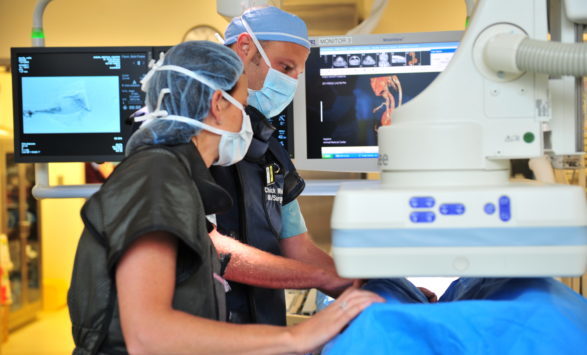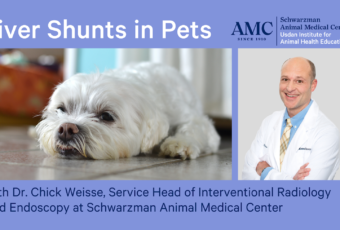Liver Shunt or Portosystemic Shunt (PSS) in Dogs

Background
A liver shunt, also called a portosystemic shunt (PSS), is an abnormal blood vessel that bypasses or “shunts” blood around the liver instead of following a normal pathway through it. The liver is vital for building proteins or removing toxins from the blood, so when the liver is bypassed, toxins and waste continue to circulate throughout the already compromised body. This can stunt your pet’s growth, as well as lead to nervous system problems such as stumbling, seizures, or head pressing.
There are two categories of shunts, extrahepatic (outside the liver) and intrahepatic (inside the liver). While most portosystemic shunts are congenital (present from birth), in some circumstances, portosystemic shunts may develop as a result of another problem with the liver (acquired shunt). In dogs with congenital shunts, signs often appear at a young age.
Risk Factors
Liver shunts occur most often in purebred dogs, and are seen most frequently among the following breeds:
- Bernese mountain dogs
- Havanese
- Huskies
- Irish wolfhounds
- Labrador retrievers
- Maltese
- Norwich terriers
- Pugs
- Yorkshire terriers
Signs
Signs of a liver shunt include:
- Failure to grow and thrive
- Nervous system disturbances, including stumbling, seizures, and head pressing
However, some dogs may be asymptomatic.
Diagnosis
In a dog with signs of a liver shunt, a complete blood count, liver enzyme analysis, and a bile acid test are the starting points for diagnosis. Dogs with shunts are commonly anemic, have elevated liver enzymes, and extreme elevation in bile acids. A urinalysis is also regularly performed because the urine of dogs with liver shunts may contain ammonium biurate crystals. In some dogs, urate bladder stones occur.
An abdominal ultrasound may be able to identify a shunt, but the preferred diagnostic imaging is computed topography (CT or “CAT” scan). This procedure can identify the location of the shunt and determine whether it is a single shunt or if there are multiple shunts. It also helps veterinary surgeons to assess whether surgical correction is possible.
Treatment
Medical management is the first step in treating the shunt. This involves reducing ammonia and other toxins circulating in the body using a prescription low-protein diet that is easily digested and lower in copper and iron.
Lactulose, a carbohydrate digested by certain intestinal bacteria, helps to acidify the large intestine and promote defecation. Certain antibiotics may be prescribed to decrease toxin-producing bacteria in the intestines. Most animals respond well to medical management.
For the most common shunts, surgery is the treatment of choice once medical management has stabilized the patient. Surgical treatment of a shunt involves blocking blood flow through the shunting vessel. This may be done either by placing constrictors (metal loops) around the vessels or by placing a coil inside the shunting vessel to prevent blood flow.
Prevention
Since most liver shunts are congenital, no preventive measures can be taken.
Webinar
In this webinar, Dr. Chick Weisse, Service Head of Interventional Radiology and Endoscopy at the Schwarzman Animal Medical Center in NYC, discusses the diagnosis and treatment of liver shunts (also known as portosystemic shunts, or PSS). Learn how veterinarians tackle this condition, including the cutting-edge technology that allows for a minimally invasive approach to treatment.
Make an Appointment

Interventional Radiology & Endoscopy
AMC's Interventional Radiology and Endoscopy Service is the first facility to implement a complete interventional service for veterinary patients, pioneering the use of these lifesaving procedures in companion animals.
Learn More






























